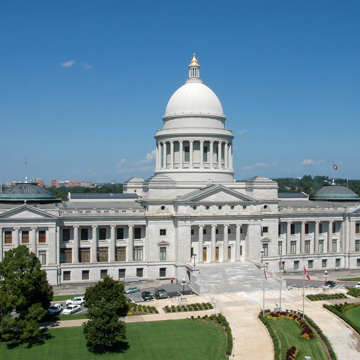In 1911, the Arkansas General Assembly met for their first session in their new state capitol, although the building was unfinished and not completed until 1915. Construction of a new seat for state government became a priority in the late nineteenth century, with structural problems and space needs plaguing the original state house (PU8). The Capitol Commission chose Little Rock architect George R. Mann’s design, which bore considerable similarities to the United States capitol in Washington, D.C., and the cornerstone was laid in 1900. Construction proceeded slowly, in part because of a lack of funding. Then in 1907 the project was halted in response to claims about structural deficiencies. The following year, George R. Donaghey was elected governor, and with his support, the Capitol Commissioners dismissed the contractors, Caldwell and Drake, and architect Mann also was released from the project. In 1909 the commission selected New York City architect Cass Gilbert, who had recently completed the much-admired Minnesota State Capitol, to submit new plans and rebuild the dome and areas of the interior. Donaghey instructed Gilbert to utilize a dome patterned on that of the Mississippi State Capitol (which happened to be a George R. Mann design), instead of the dome Mann had planned for the Arkansas capitol. Gilbert’s building, constructed of Batesville limestone on a basement level of granite, has the classical styling typical of state capitols. Its taller central section, which features a monumental pedimented portico, has flanking wings and end pavilions that also are pedimented. The capitol’s impressive form is enhanced by twelve massive Ionic columns and four engaged Ionic columns lining each of its principal east and west elevations, and Ionic columns encircling the tall drum of the central dome. The high dome, clad in Indiana limestone, is echoed by shallow domes over the end pavilions, and these indicate the house and senate chambers. The solid brass eastern entrance doors, from Tiffany’s of New York, were placed in the capitol in 1908. Mann initially specified that the interior north and south grand staircases be built of electroplated bronze on cast iron in order to stay within a mandated budget. After Gilbert was appointed, he received an increased appropriation, which enabled him to use Alabama marble on the treads and balustrades. Marble from Vermont is used for interior walls and floors, and the columns are Colorado marble. Paul Heerwagen painted four murals depicting War, Religion, Justice, and Education above the staircases that lead to the senate and house chambers.
The capitol’s grounds contain several monuments, the earliest of which is the Confederate Soldiers Monument by Fredrick Ruckstuhl. It features a bronze soldier on a granite and concrete base, with a bronze angel holding a wreath of victory over the soldier’s head. Initial fundraising for a monument to the state’s Confederate soldiers was begun by the Memorial Chapter of the United Daughters of the Confederacy in 1886, but insufficient funds delayed casting of the statue until 1904.
For many years the capitol was the only structure on the forty-two-acre capitol grounds tract, which previously was occupied by the state penitentiary (the jails’ prisoners built the capitol), but by 1939 an expansion program was underway, and the modern complex of buildings to house state government agencies (PU2) began to take shape. Between 1939 and 1957 six buildings surrounded Capitol Mall, the circular drive at the rear of the capitol building.


